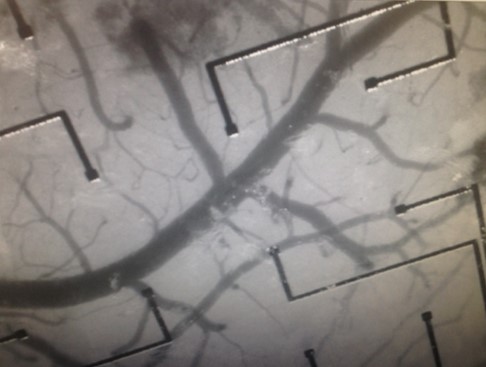Our research combines expertise in microelectronics, biophotonics, materials and biology to develop innovative tools in different biomedical fields.
Implantable neurotechnologies

microelectrode array on the mouse cortex
Textile electrodes for electrocardiography Our research focuses on using electronic and opto-electronic materials for designing and developing novel biocompatible optical and electronic devices for interfacing neural networks in the brain. This process includes design, characterization and fabrication of high-performance devices to acquire and analyze neural data and to stimulate precisely the nervous system. The ultimate objective is to apply such devices in neuroscience and translational medicine in order to improve diagnostics and treatments in the frame of neurodegenerative diseases.

Implantable neurotechnologies. From left to right: Transparent Microelectrodes – Flexible Organic Photodetector (OPD) – Flexible polymer optical fiber – Infrared neural stimulation
Wearable bioelectronics
Textiles offer a variety of advantages as mechanical supports for bioelectronic devices including low cost, conformability, and reduced invasiveness. We are exploring the integration of different bioelectronic devices on textiles, including electrodes, transistors and biochemical sensors. We use traditional and non-traditional patterning techniques such as photolithography and printing. The aim is to develop a family of medical devices for long-term monitoring of patients in the clinic and for applications in sports and recreation.

Wearable Bioelectronics. From left to right: Textile electrode for electrocardiography – Tattoo electrode – Bioelectronic facemask
Oncoelectronics
Cancer is a disease with electrical aspects that have yet to be exploited therapeutically. We are developing new ways of electrically interfacing with and controlling malignant tissue with pulsed electric fields, pursuing a device-based electroceutical approach to cancer therapeutics which we call Oncoelectronics. At the moment, we are exploring the potential of flexible organic electronic technology for the application of bioelectric therapeutics and the sensing of cancer. This fusion of bioelectronics and bioelectrics aims to develop new delivery devices for electropulsation and electroporation-related therapeutics (electrochemotherapy, electrogenetherapy, irreversible electroporation and ultrashort pulsed electric therapies). Current projects include the development of microelectrode arrays for in vitro multiwell, high throughput imaging-based screening studies of bioelectric effects on cancer, and the development of flexible organic electrode arrays for the delivery of pulsed electric fields in vivo for preclinical cancer investigations.

Oncoelectronics. From left to right: Vasularized model of Glioblastoma (B&W) – Fluorescence image of Vascularized model of Glioblastoma – Flexible electrodes for electrotherapies – Study of the effect of electroporation on the tumor and blood vessels